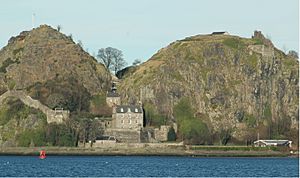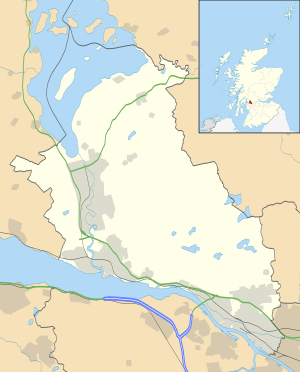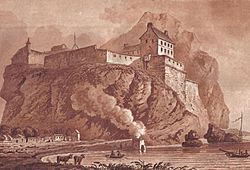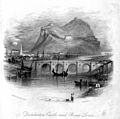Dumbarton Castle facts for kids
Quick facts for kids Dumbarton Castle |
|
|---|---|
| Dumbarton, Scotland GB grid reference |
|

View of Dumbarton Castle from across the River Clyde
|
|
| Coordinates | 55°56′10″N 4°33′46″W / 55.9360°N 4.5628°W |
| Site information | |
| Owner | Scottish Government |
| Controlled by | Historic Environment Scotland |
| Open to the public |
Yes |
| Site history | |
| Built | Site occupied since the Iron Age |
| In use | Still in use today |
Dumbarton Castle (Scottish Gaelic: Dùn Breatainn) is a very old and important castle in Scotland. It has the longest known history of any fortress in the country! The castle sits on a huge rock called Dumbarton Rock, which is about 73 meters (240 feet) tall. This rock is actually an ancient volcanic plug, meaning it's the hard core of a volcano that has worn away over millions of years.
Contents
History of Dumbarton Castle
Dumbarton Rock was formed about 334 million years ago. The softer parts of the volcano have disappeared over time, leaving behind the strong basalt rock we see today.
Ancient Times: Iron Age and Early Medieval Era
People have lived on Dumbarton Rock since at least the Iron Age. This shows how important its location was for defense. The people living there even traded with the Romans. The first written record about the settlement was in a letter from Saint Patrick in the late 400s.
From the 400s to the 800s, Dumbarton Castle was the main center of the independent Kingdom of Strathclyde. Its ancient name was Alt Clut, meaning "Rock of the Clyde." A famous king of Dumbarton, Riderch Hael, lived around AD 570 and is mentioned in old Welsh stories. Some legends even say that the wizard Merlin stayed at Alt Clut.
In 756, the fortress was captured by a combined force of Picts and Northumbrians, but they lost it again quickly. By 870, it was a busy British settlement and the capital of Alt Clut. However, in 871, Viking kings Amlaíb and Ímar attacked Dumbarton Rock. The castle fell after four months because its water supply ran out. The Vikings took many prisoners back to Ireland. After this, the capital of the kingdom moved further up the River Clyde.
Medieval Era: A Royal Stronghold
In the Middle Ages, Dumbarton Castle was a very important royal castle in Scotland. It offered safety to King David II and his young wife, Joan, after a big Scottish defeat in 1333.
In 1425, the castle was attacked by James the Fat, who was rebelling against King James I. James the Fat burned the town of Dumbarton but could not capture the castle. Its defender, John Colquhoun, successfully held out against the attackers.
In 1489, supporters of the previous king, James III, gathered at Dumbarton Castle. They hoped to get help from England, but King James IV defeated them in battle.
King James IV often used Dumbarton as a base for his navy. It was a good spot on the west coast for his trips to the Western Isles. In 1494, a special row barge was built at Dumbarton for the king, using wood from nearby Loch Lomond. The castle also stored cannons and other weapons for the king's ships. In 1505, James IV used Dumbarton as his base for another visit to the Western Isles. He even had a sword belonging to the famous William Wallace repaired there!
Regent Albany, James V, and Mary, Queen of Scots
In 1515, Regent Albany arrived at Dumbarton with several royal ships. These ships were repaired at the castle, and new docks were built for them. Regent Albany even held court at Dumbarton.
Later, in 1526, John Stewart, 3rd Earl of Lennox tried to fortify Dumbarton against the Douglas family, who controlled the young King James V. However, Lennox's forces were defeated. King James V later used the castle as a prison for people who had broken the law. In 1540, James V sailed around Scotland, arriving at Dumbarton with many important people and soldiers.
During a war called the "Rough Wooing," Mary, Queen of Scots was kept safe at Dumbarton Castle. In 1544, weapons and money from France arrived at the castle, secured by the Earl of Lennox. Lennox made a deal with King Henry VIII to give him Dumbarton Castle, but the castle's keeper refused.
In 1545, Lennox tried to take the castle back, but Regent Arran besieged it with a larger force and cannons. The castle surrendered after 20 days. Mary, Queen of Scots, stayed at the castle for several months in 1548 before sailing to France for her safety. Her journey was delayed by bad winds, but she eventually sailed around Ireland to avoid English ships. In France, she was soon engaged to the young French prince, Francis.
Later Years: Civil War and Decline
After a battle in 1568, John Fleming, 5th Lord Fleming, who was the castle's keeper, supported Mary, Queen of Scots. The castle became a stronghold for Mary's supporters during the Marian Civil War. In 1570, the castle was strengthened using stones from demolished churches and houses in the area.
However, in April 1571, forces loyal to King James VI captured the castle in a surprise attack. They used ladders to climb the steep rock and took the garrison by surprise. Dumbarton Castle was later used as a prison for Regent Morton before his execution in 1581.
In the 1600s, some repairs and new buildings were added, including a replacement for the old Wallace Tower. However, by 1644, the Scottish Parliament thought the castle might be more harmful than helpful to the country. Its importance as a military fortress slowly faded after 1658. Still, because of threats from Jacobites and the French in the 1700s, new defenses were built. The castle remained a military base until World War II.
The Castle Today
Today, you won't see any buildings from the very early times of Alt Clut. Not much of the medieval castle remains either, except for parts of the 14th-century Portcullis Arch and the foundations of the Wallace Tower. There is also a 16th-century guard house with a face carved into it, which legend says is "Fause Menteith," the person who supposedly betrayed William Wallace.
Most of the buildings you see today were built in the 1700s. These include the Governor's House and other defenses. The amazing views from the two high points of the rock, the White Tower Crag and the Beak, show why this rocky spot was chosen as "the fortress of the Britons" so many centuries ago.
Dumbarton Castle is open to visitors most of the year. To explore the castle, you need to climb 557 steps to reach the White Tower Crag and other areas.
Dumbarton Rock is owned by the Scottish Government and is a protected Ancient Monument. This helps make sure it is preserved for future generations to enjoy. Activities like rock climbing are not allowed, as any damage to the site is against the law.
Images for kids
-
Dumbarton Castle, 1836 engraving by William Miller after J M W Turner
See also
 In Spanish: Castillo de Dumbarton para niños
In Spanish: Castillo de Dumbarton para niños






